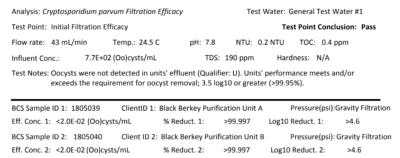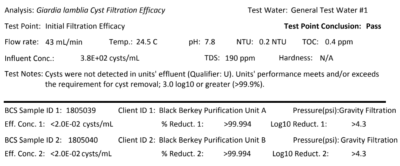Water parasites: CRYPTOSPORIDIUM AND GIARDIA, Main causes of diseases
Share

Found all over the world, Cryptosporidium parvum (often called simply "Crypto") and Giardia lamblia ("Giardia") are common protozoan parasites that are two of the leading causes of waterborne diseases.
What is a protozoan?
Protozoa are single-celled microscopic organisms that are often parasitic, but can also live outside of a host. The Centers for Disease Control and Prevention notes that protozoa are "capable of multiplying in humans, which contributes to their survival and also allows serious infections to develop from a single organism." 1
What is a parasite?
“Parasite” is a general term for any organism that survives at the expense of its host. The CDC defines parasites as “an organism that lives on or in a host organism and feeds on or at the expense of its host.” There are three major classes of parasites that can cause disease in humans: protozoa, helminths, and ectoparasites.” 2
What are cryptosporidiosis and giardiasis, and how are they spread?
Cryptosporidiosis and giardiasis are two common gastrointestinal illnesses caused by ingesting water contaminated with cryptosporidium or giardia. The parasites attach to the intestines of humans and animals, and are then transmitted into the environment through food or person-to-person contact with the feces of infected humans or animals.
Difficult to eradicate
Cryptosporidium and Giardia are protected by chlorine-resistant outer coverings (oocysts and cysts, respectively) that allow the parasites to live for long periods outside their original host. Giardia cysts can survive for several months in cold water 3 , while Cryptosporidium oocysts can survive for months in soil under cool, dark conditions and up to a year in low turbidity water. 4
Stream easily
The numbers are alarming: millions of infectious oocysts and cysts can be passed in a single bowel movement, 5 but it only takes swallowing a small amount of water (as few as ten Giardia cysts) 6 to infect a human. 7, 8 So, it's easy to understand why an infectious person suffering from diarrhea, a leaky diaper, or an all-too-frequent "bowel accident" in a pool, spa, or small lake could pose such a potential health hazard.
In addition to water as a source of transmission, it is important to note that food, soil, doorknobs, faucets, toys, or anything commonly shared or touched can also be contaminated. The ease with which these organisms can spread shows why it is so important to observe hygiene practices this summer, especially when handling food at outdoor parties and picnics, sharing phones and cameras, or even after bathroom trips.
NUMBER OF CASES REPORTED
In 2012, there were 15,223 reported cases of giardiasis 9 and 8,008 cases of cryptosporidiosis. ten
CONTACT SOURCES
Water is the most common mode of transmission. Parasites that cause cryptosporidiosis and giardiasis can be found in almost any water source, including:
Streams
lakes
Swimming pools
Hot tub spas
Well 11
Is the public water supply also vulnerable?
Although raw water such as lakes and streams is a major source of contamination, public water supplies are not immune to these parasites. Tap water may also be affected. 12
According to Ohio State University:
These pests are not effectively controlled by chlorination or other disinfectants. Chlorine used to kill bacteria in municipal water is not added at a sufficient concentration or for a sufficient duration to kill chlorine-resistant Giardia, Crypto, and Cyclospora. Water filtration is the common practice to control these parasites; therefore, municipal drinking water programs are essential for protection. When municipal water is not available, boiling for at least 1 minute is an effective method of controlling these pests in the water supply. 13
The Saskatchewan Water Safety Agency notes:
These two parasites [Cryptosporidium and Giardia] are found in the water of lakes and streams, and in some groundwater sources under the direct influence of surface water. Communities that obtain their drinking water from these surface water sources and do not properly treat their water can introduce the parasites into their water system. These organisms are both highly resistant to chlorine and other disinfectants used to kill bacteria and viruses in drinking water. Additionally, Cryptosporidium and Giardia exist as oocysts (cysts) or spores in the environment and are small enough to pass certain types of filters used in conventional water treatment. 14
Have there been any notable, widespread outbreaks?
Milwaukee, April 1993
The largest waterborne outbreak in history occurred in 1993. An estimated 403,000 Milwaukee residents suffered from watery diarrhea due to Cryptosporidium oocysts found in the city's public water supply. Four thousand were hospitalized and more than 100 died. 15 One of the city's water treatment plants was temporarily shut down, but by the time the boil water notice was announced, the pathogen had been in the city's water system for more than two weeks. 16
The city of Milwaukee has since spent more than $200 million to upgrade the city's water treatment and distribution system. Turbidity (or cloudiness, an indicator of the concentration of particles suspended in water) is now continuously measured and particle counters have been installed on the city's water filters. 17
The 1993 crisis demonstrated the need for greater awareness and understanding of cryptosporidium as a public health risk. Other lessons and needs identified included testing source and finished water for cryptosporidium, conducting environmental studies, and the important role the media could play in communicating important public health messages during the outbreak. 18
What are the symptoms and health effects of cryptosporidiosis and giardiasis?
Resembling what you would call a severe case of food poisoning or a nasty "belly bug," the two illnesses have very similar symptoms, which can include:
Foul-smelling or watery diarrhea
Stomach cramps or pain
Lack of appetite
Weight loss
Bloating
Nausea and vomiting
Mild fever
Fatigue
Flatulence
Headaches 19
Although the symptoms are basically the same, the time period between the initial ingestion of the parasite and the symptoms manifesting is slightly different between the two diseases:
Symptoms of cryptosporidiosis may appear within a week of infection and last up to two weeks, although they may come and go sporadically for up to a month 20. There is no specific treatment for cryptosporidiosis, but medications are available to help treat the symptoms 21.
Symptoms of giardiasis may take a little longer to appear (up to three weeks) and may persist for two to six weeks or even longer 22 . Treatments are available for giardiasis. 23
Some people harbor the parasites but show no effects. Most cases go away on their own, but if you think you may have contracted cryptosporidiosis or giardiasis, it's always a good idea to seek the advice and care of your doctor or healthcare professional of choice.
Who is most at risk for severe or severe cases of cryptosporidiosis or giardiasis?
Again, many people infected with these two parasites will not notice any symptoms or feel sick. However, the Saskatchewan Water Security Agency notes that certain groups such as children and pregnant women are more likely to develop more severe illness. 24
People at risk of serious illness after becoming infected include:
People with AIDS
People with cancer
Organ or bone marrow transplant patients taking medications to suppress the immune system
People born with weakened immune systems 25
Are cases more common at certain times of the year?
Reported cases are typically highest during warm months, when more people are exposed to parasites while enjoying the water for outdoor recreation. In 2011-2012, the CDC reported a peak in giardiasis occurrence from early summer to early fall. 26 During this same period, the appearance of cryptosporidiosis symptoms increased 4.4-fold in late summer. 27
How can I reduce my risk of becoming infected?
The Ohio State University suggests doing the following to reduce your chances of suffering from the effects of giardiasis and cryptosporidiosis:
OUTDOOR
Wash your hands with warm water and soap before eating or drinking.
When swimming in a lake, river or stream, try not to swallow the water.
Drink water from sources such as municipal water whenever possible.
If treated water is not available, boil the water for at least 1 minute before drinking. 25
AT HOME
Wash your hands with warm water and soap before eating or drinking.
Wash all raw fruits and vegetables under running water from a treated source.
When drinking milk and juice, use only pasteurized products.
Use a vegetable brush to scrub the outside of fruits and vegetables.
Be aware of public boil alerts and follow recommendations. 28
PUBLIC POOLS AND WATER PARKS
Additionally, for those whose idea of "roughing it" on vacation involves lazy afternoons at their hotel pool, the CDC notes that a third of treated recreational waterborne disease outbreaks between 2000 and 2014 occurred in hotel pools or hot tubs according to a report published in the CDC's Morbidity and Mortality Weekly Report.
Therefore, the CDC suggests taking the following precautions:
Do not swim or let your children swim if they have diarrhea. If Crypto is the cause of the diarrhea, wait 2 weeks after the diarrhea stops to go swimming.
Check inspection scores for swimming pools, hot tubs and water play areas.
Before entering the water, use a test strip from your local retailer or pool supply store to check if the water's pH and bromine or free chlorine are correct.
Do not swallow the water.
Take children to the bathroom every hour and change diapers in a changing area and away from water. 29
YOUR BEST DEFENSE IS A FINAL BARRIER SYSTEM
As you can see, cryptosporidium and giardia are literally everywhere and present a real problem not only for raw water sources, but also for modern water systems. Since cryptosporidium and giardia are chlorine resistant and boiling water is time and labor intensive (not to mention providing small amounts of water at a time), your best defense is to have a final barrier system in place to purify your drinking water daily. base.
When selecting a system, inspect test results for pests such as Giardia and Cryptosporidium. Below you will find information about Black Berkey ® purification elements.
CRYPTOPORIDIUM REDUCTION AND GIARDIA REDUCTION TEST RESULTS OF BLACK BERKEY ® PURIFICATION ELEMENT
Drink with Confidence: Independent laboratory tests show our elements to be extremely effective at removing these stray contaminants. Indeed, no cysts were detected in the effluent of the system tested for the two contaminants. This is important considering that consuming just 10 Giardia cysts can cause infection. 30
CRYPTOSPORIDIUM
The United States Environmental Protection Agency's minimum removal or inactivation standard for cryptosporidium is 99%, a 2 log reduction. Black Berkey ® purification elements exceed laboratory detectable limits, removing cryptosporidium by more than 99.997% (log 4.6). That's more than double the EPA standard, by log 2.6.
What is a protozoan?
Protozoa are single-celled microscopic organisms that are often parasitic, but can also live outside of a host. The Centers for Disease Control and Prevention notes that protozoa are "capable of multiplying in humans, which contributes to their survival and also allows serious infections to develop from a single organism." 1
What is a parasite?
“Parasite” is a general term for any organism that survives at the expense of its host. The CDC defines parasites as “an organism that lives on or in a host organism and feeds on or at the expense of its host.” There are three major classes of parasites that can cause disease in humans: protozoa, helminths, and ectoparasites.” 2
What are cryptosporidiosis and giardiasis, and how are they spread?
Cryptosporidiosis and giardiasis are two common gastrointestinal illnesses caused by ingesting water contaminated with cryptosporidium or giardia. The parasites attach to the intestines of humans and animals, and are then transmitted into the environment through food or person-to-person contact with the feces of infected humans or animals.
Difficult to eradicate
Cryptosporidium and Giardia are protected by chlorine-resistant outer coverings (oocysts and cysts, respectively) that allow the parasites to live for long periods outside their original host. Giardia cysts can survive for several months in cold water 3 , while Cryptosporidium oocysts can survive for months in soil under cool, dark conditions and up to a year in low turbidity water. 4
Stream easily
The numbers are alarming: millions of infectious oocysts and cysts can be passed in a single bowel movement, 5 but it only takes swallowing a small amount of water (as few as ten Giardia cysts) 6 to infect a human. 7, 8 So, it's easy to understand why an infectious person suffering from diarrhea, a leaky diaper, or an all-too-frequent "bowel accident" in a pool, spa, or small lake could pose such a potential health hazard.
In addition to water as a source of transmission, it is important to note that food, soil, doorknobs, faucets, toys, or anything commonly shared or touched can also be contaminated. The ease with which these organisms can spread shows why it is so important to observe hygiene practices this summer, especially when handling food at outdoor parties and picnics, sharing phones and cameras, or even after bathroom trips.
NUMBER OF CASES REPORTED
In 2012, there were 15,223 reported cases of giardiasis 9 and 8,008 cases of cryptosporidiosis. ten
CONTACT SOURCES
Water is the most common mode of transmission. Parasites that cause cryptosporidiosis and giardiasis can be found in almost any water source, including:
Streams
lakes
Swimming pools
Hot tub spas
Well 11
Is the public water supply also vulnerable?
Although raw water such as lakes and streams is a major source of contamination, public water supplies are not immune to these parasites. Tap water may also be affected. 12
According to Ohio State University:
These pests are not effectively controlled by chlorination or other disinfectants. Chlorine used to kill bacteria in municipal water is not added at a sufficient concentration or for a sufficient duration to kill chlorine-resistant Giardia, Crypto, and Cyclospora. Water filtration is the common practice to control these parasites; therefore, municipal drinking water programs are essential for protection. When municipal water is not available, boiling for at least 1 minute is an effective method of controlling these pests in the water supply. 13
The Saskatchewan Water Safety Agency notes:
These two parasites [Cryptosporidium and Giardia] are found in the water of lakes and streams, and in some groundwater sources under the direct influence of surface water. Communities that obtain their drinking water from these surface water sources and do not properly treat their water can introduce the parasites into their water system. These organisms are both highly resistant to chlorine and other disinfectants used to kill bacteria and viruses in drinking water. Additionally, Cryptosporidium and Giardia exist as oocysts (cysts) or spores in the environment and are small enough to pass certain types of filters used in conventional water treatment. 14
Have there been any notable, widespread outbreaks?
Milwaukee, April 1993
The largest waterborne outbreak in history occurred in 1993. An estimated 403,000 Milwaukee residents suffered from watery diarrhea due to Cryptosporidium oocysts found in the city's public water supply. Four thousand were hospitalized and more than 100 died. 15 One of the city's water treatment plants was temporarily shut down, but by the time the boil water notice was announced, the pathogen had been in the city's water system for more than two weeks. 16
The city of Milwaukee has since spent more than $200 million to upgrade the city's water treatment and distribution system. Turbidity (or cloudiness, an indicator of the concentration of particles suspended in water) is now continuously measured and particle counters have been installed on the city's water filters. 17
The 1993 crisis demonstrated the need for greater awareness and understanding of cryptosporidium as a public health risk. Other lessons and needs identified included testing source and finished water for cryptosporidium, conducting environmental studies, and the important role the media could play in communicating important public health messages during the outbreak. 18
What are the symptoms and health effects of cryptosporidiosis and giardiasis?
Resembling what you would call a severe case of food poisoning or a nasty "belly bug," the two illnesses have very similar symptoms, which can include:
Foul-smelling or watery diarrhea
Stomach cramps or pain
Lack of appetite
Weight loss
Bloating
Nausea and vomiting
Mild fever
Fatigue
Flatulence
Headaches 19
Although the symptoms are basically the same, the time period between the initial ingestion of the parasite and the symptoms manifesting is slightly different between the two diseases:
Symptoms of cryptosporidiosis may appear within a week of infection and last up to two weeks, although they may come and go sporadically for up to a month 20. There is no specific treatment for cryptosporidiosis, but medications are available to help treat the symptoms 21.
Symptoms of giardiasis may take a little longer to appear (up to three weeks) and may persist for two to six weeks or even longer 22 . Treatments are available for giardiasis. 23
Some people harbor the parasites but show no effects. Most cases go away on their own, but if you think you may have contracted cryptosporidiosis or giardiasis, it's always a good idea to seek the advice and care of your doctor or healthcare professional of choice.
Who is most at risk for severe or severe cases of cryptosporidiosis or giardiasis?
Again, many people infected with these two parasites will not notice any symptoms or feel sick. However, the Saskatchewan Water Security Agency notes that certain groups such as children and pregnant women are more likely to develop more severe illness. 24
People at risk of serious illness after becoming infected include:
People with AIDS
People with cancer
Organ or bone marrow transplant patients taking medications to suppress the immune system
People born with weakened immune systems 25
Are cases more common at certain times of the year?
Reported cases are typically highest during warm months, when more people are exposed to parasites while enjoying the water for outdoor recreation. In 2011-2012, the CDC reported a peak in giardiasis occurrence from early summer to early fall. 26 During this same period, the appearance of cryptosporidiosis symptoms increased 4.4-fold in late summer. 27
How can I reduce my risk of becoming infected?
The Ohio State University suggests doing the following to reduce your chances of suffering from the effects of giardiasis and cryptosporidiosis:
OUTDOOR
Wash your hands with warm water and soap before eating or drinking.
When swimming in a lake, river or stream, try not to swallow the water.
Drink water from sources such as municipal water whenever possible.
If treated water is not available, boil the water for at least 1 minute before drinking. 25
AT HOME
Wash your hands with warm water and soap before eating or drinking.
Wash all raw fruits and vegetables under running water from a treated source.
When drinking milk and juice, use only pasteurized products.
Use a vegetable brush to scrub the outside of fruits and vegetables.
Be aware of public boil alerts and follow recommendations. 28
PUBLIC POOLS AND WATER PARKS
Additionally, for those whose idea of "roughing it" on vacation involves lazy afternoons at their hotel pool, the CDC notes that a third of treated recreational waterborne disease outbreaks between 2000 and 2014 occurred in hotel pools or hot tubs according to a report published in the CDC's Morbidity and Mortality Weekly Report.
Therefore, the CDC suggests taking the following precautions:
Do not swim or let your children swim if they have diarrhea. If Crypto is the cause of the diarrhea, wait 2 weeks after the diarrhea stops to go swimming.
Check inspection scores for swimming pools, hot tubs and water play areas.
Before entering the water, use a test strip from your local retailer or pool supply store to check if the water's pH and bromine or free chlorine are correct.
Do not swallow the water.
Take children to the bathroom every hour and change diapers in a changing area and away from water. 29
YOUR BEST DEFENSE IS A FINAL BARRIER SYSTEM
As you can see, cryptosporidium and giardia are literally everywhere and present a real problem not only for raw water sources, but also for modern water systems. Since cryptosporidium and giardia are chlorine resistant and boiling water is time and labor intensive (not to mention providing small amounts of water at a time), your best defense is to have a final barrier system in place to purify your drinking water daily. base.
When selecting a system, inspect test results for pests such as Giardia and Cryptosporidium. Below you will find information about Black Berkey ® purification elements.
CRYPTOPORIDIUM REDUCTION AND GIARDIA REDUCTION TEST RESULTS OF BLACK BERKEY ® PURIFICATION ELEMENT
Drink with Confidence: Independent laboratory tests show our elements to be extremely effective at removing these stray contaminants. Indeed, no cysts were detected in the effluent of the system tested for the two contaminants. This is important considering that consuming just 10 Giardia cysts can cause infection. 30
CRYPTOSPORIDIUM
The United States Environmental Protection Agency's minimum removal or inactivation standard for cryptosporidium is 99%, a 2 log reduction. Black Berkey ® purification elements exceed laboratory detectable limits, removing cryptosporidium by more than 99.997% (log 4.6). That's more than double the EPA standard, by log 2.6.

GIARDIA
The EPA minimum removal or inactivation standard for Giardia lamblia is 99.9%, a 3 log reduction. Black Berkey® Purification elements exceed laboratory detectable limits, having been tested to reduce Giardia cysts by more than 99.994%, or 4.6 log. This also exceeds the EPA standard.
The EPA minimum removal or inactivation standard for Giardia lamblia is 99.9%, a 3 log reduction. Black Berkey® Purification elements exceed laboratory detectable limits, having been tested to reduce Giardia cysts by more than 99.994%, or 4.6 log. This also exceeds the EPA standard.

See the full information in the knowledge base.
THE BOTTOM LINE
Berkey ® systems equipped with Black Berkey ® purification elements eliminate up to 99.999% of viruses and 99.9999% of pathogenic bacteria, while eliminating or significantly reducing trihalomethanes, inorganic minerals, heavy metals, pharmaceuticals, pesticides, VOCs, petroleum products, perfluorinated chemicals, rust, silt, sediment and even radiological products. Enjoy clean, delicious purified water that retains the healthy minerals your body needs for less than 2 cents per gallon of purified water. A pair of Black Berkey ® purification elements lasts up to 6,000 gallons, or approximately 5 years with typical use.
Berkey ® systems equipped with Black Berkey ® purification elements eliminate up to 99.999% of viruses and 99.9999% of pathogenic bacteria, while eliminating or significantly reducing trihalomethanes, inorganic minerals, heavy metals, pharmaceuticals, pesticides, VOCs, petroleum products, perfluorinated chemicals, rust, silt, sediment and even radiological products. Enjoy clean, delicious purified water that retains the healthy minerals your body needs for less than 2 cents per gallon of purified water. A pair of Black Berkey ® purification elements lasts up to 6,000 gallons, or approximately 5 years with typical use.
Learn more about Black Berkey ® purification elements by reading these related articles or visiting our knowledge base:
Fluoride and Water Filters: Understanding Effective Reduction
Leptospirosis: a serious illness often spread through raw, contaminated water
Black Berkey ® purification elements: the last barrier against PFOA and other PFCs in drinking water
Do Black Berkey ® purification elements eliminate cyanobacteria associated with algae blooms?
Berkey ® Systems' Newest Lead Water Test Now Available
Black Berkey ® Purification Element Test Results
REFERENCES:
(1) CDC.gov: About Pests
Leptospirosis: a serious illness often spread through raw, contaminated water
Black Berkey ® purification elements: the last barrier against PFOA and other PFCs in drinking water
Do Black Berkey ® purification elements eliminate cyanobacteria associated with algae blooms?
Berkey ® Systems' Newest Lead Water Test Now Available
Black Berkey ® Purification Element Test Results
REFERENCES:
(1) CDC.gov: About Pests
(30) Giardiasis outbreaks in the United States, 1971-2011
SHARE THIS IMPORTANT INFORMATION
Understanding is key. Share this with others so they can make informed choices about their water.
SHARE THIS IMPORTANT INFORMATION
Understanding is key. Share this with others so they can make informed choices about their water.
